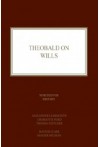- Author(s): Alexander Learmonth QC, Charlotte Ford, Thomas Fletcher
- Publisher: West Thomson Reuters
- Edition: 19 South Asian Ed 2023
- ISBN 13 9789393702876
- Approx. Pages 1048 + contents
- Format Hardbound
- Approx. Product Size 24 x 18 cms
- Delivery Time Normally 7-9 working days
- Shipping Charge Extra (see Shopping Cart)
.............................................................................................................................
Description
The law of Wills is rather like one of those country houses that have been altered and enlarged over time. In the remains of a monastery, perhaps, a Tudor mansion was constructed. Then, in the eighteenth century, a fine new wing was built, in the style of Palladio. In the alternative, perhaps, the new wing was not built until the reign of Queen Victoria, and the style was not Palladian, but Gothic Revival. At this point, however, the analogy breaks down. The size and structure of the house will have changed little,
if at all, during the twentieth century. If the house had followed the example of the law of Wills, by contrast, if would have
seen extensive alteration, both internal and external. Picturesque cubby-holes and winding staircases would have been removed. Many rooms would have been redecorated in a new style. Modern knowledge would have improved the experience of living in the house, not least by opening new windows to let in more light (that is to say, extrinsic evidence). Above all, completely new buildings would have been added, attached to but to some degree separate from the older house. One would have been the family provision building, another the breach of duty building. These new buildings would have been used as much as any of the older parts of the house, and more than many of them. Readers of this book may well make most use of two classes of chapter. One class is made up of the modern, or relatively modern, subjects of family provision, breach of duty, proprietary estoppel and constructive trusts. The other class comprises those subjects that are of ancient origin, but are central to the law of Wills, come before the lawyer frequently, and continue to develop. The principles governing the formal and substantial validity of wills is the most important of these old but thriving subjects.
Much of the book covers subjects that do not fall into either of these two classes. Pre-eminent here is the material dealing with the meaning and effect of the language used in Wills, that is to say the construction of Wills. The chapters concerned with this may not be consulted as often as those in the two classes already mentioned. They will receive fewer "hits", in the language of the Internet. They are nevertheless very important, for at least three reasons. First, some lawyers are regularly concerned with problems of construction. Secondly, many others have to consider them from time to time. The plaintive requests for views on such problems in the Trusts Discussion Forum are evidence enough of that (and prompt our regret that the authors of the requests had not equipped themselves with a copy of Theobald). Thirdly, knowledge of problems and potential problems helps the drafter to understand why precedents use language in the way they do, and is very useful when he or she leaves the manicured lawns and clear paths of the printed precedents, to create by bespoke drafting the pathway required by the client.
.............................................................................................................................
Contents
Section A: Introduction
1. Wills and Other Testamentary Instruments
2. Wills and Conflict of Laws
Section B: Making A Will
3. Substantial Validity
4. Formal Validity
5. Incorporation of Documents
6. Alterations
7. Revocation, Revival and Republication
8. What Property May be Disposed of by Will?
9. The Equitable Doctrine of Election
10. Who May be Devisees or Legatees?
Section C: Procedure for Contentious Probate Claims
11. Preliminary steps and parties
12. The claim form, acknowledgement, evidence of testamentary
13. Case management and pre-trial procedure
14. Trial
15.. Costs
16. Provision for Deceased's Family and De pendants
Section D: Understanding A Will
17. Admissibility of Evidence as an Aid to Construction
18. General Principles of Construction
19. Alteration and Revoking Gifts
20. Types of Legacy
21. Gifts Over
22. Testamentary Options
23. Gifts of Annuities
24. Gifts for Charitable Purposes
25. Residuary Gifts and Partial Intestacy
26. Description of Things
27. Description of Beneficiaries: General
28. Description of Beneficiaries: Relationships
29. Description of Beneficiaries: Children
30. Description of Beneficiaries: Class Gifts
31. Descriptions of Interests
32. Conditions
33. Vesting
34. Perpetuity and Accumulation
35. Execution of Powers
Section D: Giving Effect To Wills
36. Probate and its Effect
37. Administration
38. Administrative Powers of Trustees
39. Rules Against Double Portions and Other Double Provision
40. Ademption
41. Income or Interest Carried by Gifts
42. Rights Between Tenant for Life and Remainderman
Section E: Professional Negligence
43. Professional Negligence
.............................................................................................................................
Author Details
ALEXANDER LEARMONTH, BA QC, Barrister of Lincoln's Inn One of Her Majesty's Counsel
JULIA CLARKE, A Master of the Senior Courts, Chancery Division
KAREN SHUMAN, A Master of the Senior Courts, Chancery Division
CHARLOTTE FORD, MA Cantab, Barrister of Lincoln's Inn
THOMAS FLETCHER, MA, LLM. Barrister of the Inner Temple
.............................................................................................................................

